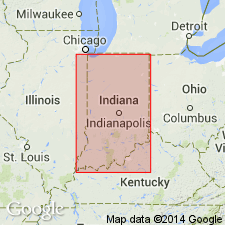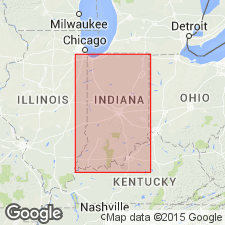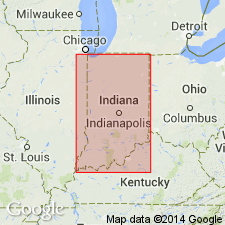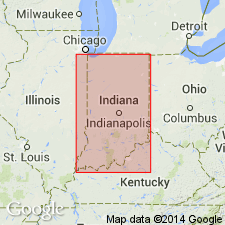
- Usage in publication:
-
- Pendleton sandstone
- Modifications:
-
- Named
- Dominant lithology:
-
- Sandstone
- AAPG geologic province:
-
- Cincinnati arch
Summary:
Pendleton sandstone in eastern IN is here described as heavy-bedded soft white sandstone, 15 ft thick. Upper part contains Schoharie fossils according to James Hall. Assigned to Corniferous. Overlain by buff sandy Corniferous limestone and underlain by Niagara limestone.
Source: GNU records (USGS DDS-6; Reston GNULEX).

- Usage in publication:
-
- Pendleton sandstone
- Modifications:
-
- Overview
- AAPG geologic province:
-
- Cincinnati arch
Summary:
Pendleton is stratigraphic equivalent of Jeffersonville limestone. Locally contains a conglomerate bed near top. Formation is 15 ft thick at Pendleton.
Source: GNU records (USGS DDS-6; Reston GNULEX).

- Usage in publication:
-
- Pendleton formation
- Modifications:
-
- Revised
- AAPG geologic province:
-
- Cincinnati arch
Summary:
All beds at Pendleton considered as a unit, the Pendleton formation. Regarded as essentially equivalent to lower Geneva and Jeffersonville, a third lithologic facies of same stratigraphic unit. Conclusion based on similarity of fossils and on paleographic considerations that seem to make correlations with Schoharie untenable.
Source: GNU records (USGS DDS-6; Reston GNULEX).

- Usage in publication:
-
- Pendleton Sandstone Bed
- Modifications:
-
- Revised
- AAPG geologic province:
-
- Cincinnati arch
Summary:
Jeffersonville Limestone of Muscatatuck Group is here subdivided. Pendleton Sandstone Bed (rank reduced) is assigned to the Vernon Fork Member of the Jeffersonville. Age is Middle Devonian.
Source: GNU records (USGS DDS-6; Reston GNULEX).

- Usage in publication:
-
- Pendleton Sandstone Bed
- Modifications:
-
- Overview
- AAPG geologic province:
-
- Cincinnati arch
Summary:
At the type section, the Pendleton Sandstone Bed consists of white and varicolored fine-grained well-sorted calcareous sandstone that is fairly pure but that is partly ferruginous, laminated, and fossiliferous. Reference to a conglomerate in the upper part in early reports was probably in error. Distribution is spotty and recognition is difficult as the sand grades both vertically and laterally into pale-colored fine-grained to micritic sandy to sparsely sandy and sand-free dolomites. At the type section, disconformably overlies Silurian Wabash Formation, but in central IN south of Madison Co. conformably overlies the Geneva Dolomite Member of the Jeffersonville. Conformably underlies Vernon Fork dolomites. The Pendleton may be diachronous or may occur in more than one stratigraphic position--at the base of and within the Jeffersonville. For consistency, the Pendleton should be considered as restricted to areas south and west of the Kankakee and Cincinnati Arches, in the same area of distribution as the Geneva Dolomite Member. Age in this report is middle Eifelian.
Source: GNU records (USGS DDS-6; Reston GNULEX).
For more information, please contact Nancy Stamm, Geologic Names Committee Secretary.
Asterisk (*) indicates published by U.S. Geological Survey authors.
"No current usage" (†) implies that a name has been abandoned or has fallen into disuse. Former usage and, if known, replacement name given in parentheses ( ).
Slash (/) indicates name conflicts with nomenclatural guidelines (CSN, 1933; ACSN, 1961, 1970; NACSN, 1983, 2005, 2021). May be explained within brackets ([ ]).

